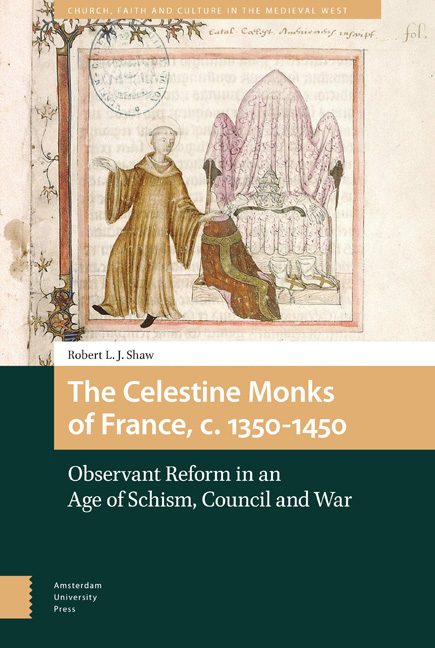Book contents
- Frontmatter
- Contents
- Maps and Figures
- Abbreviations
- Acknowledgements
- Introduction: The Celestine monks of France and the rise of ‘Observant’ reform
- Part I The French Celestines in their world
- Part II The world of the French Celestines
- Epilogue and conclusion
- Appendix 1 Lists and map
- Appendix 2 Reductions of foundation Masses (beyond anniversary Masses) at the Celestine monastery of Paris, 1414 and 1436
- Appendix 3 Reduction of foundation Masses (beyond anniversary masses) at the Celestine monastery of Sens, 1414
- Index
Epilogue and conclusion
Published online by Cambridge University Press: 16 February 2021
- Frontmatter
- Contents
- Maps and Figures
- Abbreviations
- Acknowledgements
- Introduction: The Celestine monks of France and the rise of ‘Observant’ reform
- Part I The French Celestines in their world
- Part II The world of the French Celestines
- Epilogue and conclusion
- Appendix 1 Lists and map
- Appendix 2 Reductions of foundation Masses (beyond anniversary Masses) at the Celestine monastery of Paris, 1414 and 1436
- Appendix 3 Reduction of foundation Masses (beyond anniversary masses) at the Celestine monastery of Sens, 1414
- Index
Summary
What was the legacy of this period in French Celestine history? What was the position of the congregation at the end of the Hundred Years War, at the end of the division in the Church that carried through intermittently into the 1450s? Their high symbolic status did not end immediately with the collapse of Lancastrian power in France. As mentioned in Chapter 4, Charles VII placed such value on the connection between the French royal office and the Celestines that he completed John, duke of Bedford, and Henry VI's attempted foundation at Rouen, at the end of November 1449, just a few weeks after having won back the city. His words make clear that the previous grant of the Joyeux Repos manor (the duke's former residence within the city) – ‘which the defunct John, duke of Bedford, built, constructed, albeit for from the moneys of our realm, and formerly resided in’ – was as illegitimate as John's claim to the regency. Charles, meanwhile, declared himself ‘principal founder’ (fundator principalis); by founding a Celestine monastery, he followed in the footsteps of his royal predecessors, and cited similar motivations to those that had moved his grandfather Charles V. The house was founded so that ‘these same Celestines, as if a new plantation, newly planted in our Duchy of Normandy, which has until now not been decorated by a Celestine monastery, should pour out, we hope, the odour of sanctity upon all by the zeal of their religion, by the cleanliness of their way of life, and by the stricture of their regular observance.’
These words of Charles VII – citing their importance within political society, but also the features that made the monks themselves stand out as reformers – stand as further testament to the relevance that the Celestines and their ideals had found in this period. But their attractiveness to such donors in the preceding years had arguably also rendered some of their monasteries as monuments to the confusion of that period. In 1436 or 1437, Philip the Good, duke of Burgundy, built a fine tomb for his sister, Anne, duchess of Bedford, in the Celestine house of Notre-Dame de l’Annonciation in Paris.
- Type
- Chapter
- Information
- The Celestine Monks of France, c. 1350–1450Observant Reform in an Age of Schism, Council and War, pp. 261 - 268Publisher: Amsterdam University PressPrint publication year: 2018

